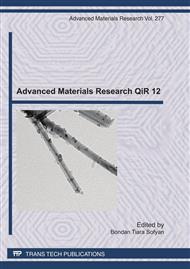p.36
p.43
p.51
p.59
p.66
p.76
p.84
p.90
p.100
The Effects of Plates Position in Vertical Casting Producing Thin Wall Ductile Iron
Abstract:
In the general rule of casting design the thickest part of the cast should be placed near to the ingate. This arrangement was meant to guarantee the completion of filling process. An unusual vertical casting design to produce plates with different thicknesses was established based on the idea that the heat from molten metal will always warm up its entire runner. In this design the thinnest plate is placed near to the ingate. The design was made for producing thin wall ductile iron. This research was conducted to see the effects of reverse thickness arrangement in casting design to the microstructure and mechanical properties of the plates. Plates produced by this design were compared to plates produced by the same design with general casting arrangement. Thicknesses of the plates produced in this casting were 1, 2, 3, 4, and 5 mm. The moulds used were made from furan sand. Beside experiment, casting design simulation with Z-Cast was also conducted to ensure the completion of filling process and to see the manner of solidification. Casting simulation showed that arrangement of plates gave different filling and solidification manners. Although there were some differences, the filling was successful for both arrangements of plates. Skin effect was found in both designs. Nodule counts and nodularity were higher in the new design while average nodule diameters were lower. The result gained in tensile and hardness test did not follow the correlations in the characteristic of graphite. Mechanical properties showed that position of plate, ignoring the thickness, influence tensile strength and hardness.
Info:
Periodical:
Pages:
66-75
Citation:
Online since:
July 2011
Price:
Сopyright:
© 2011 Trans Tech Publications Ltd. All Rights Reserved
Share:
Citation:


